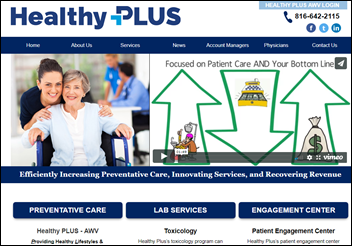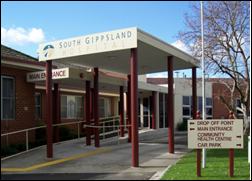News 11/15/17
Top News
American Medical Association EVP/CEO James Madara, MD pitches AMA’s recently announced Integrated Health Model Initiative at the organization’s Interim Meeting. He criticized the poor organization of clinical data sets; the lack of clinical usefulness of EHRs; the need for meaningful interoperability; and “oceans of data, but only puddles of clinical meaning.” His overriding message was that useful information is scattered throughout the EHR, it lacks context, and its needs to include patient-reported data and perceptions.
Meanwhile, AMA President David Barbe, MD cites AMA’s major wins at the same conference in which he urges attendees to recruit new AMA members. “We successfully fought to postpone a mandate for physicians to upgrade their EHRs … We are fighting to prevent IT vendors from blocking information or making it expensive for physicians to share data, and we are making progress. We are fighting physician burnout and the time crunch by working to improve EHRs, mobile devices, and interoperability, and again, those efforts are showing signs of success.”
AMA is protective of its membership count – omitting the actual number from its otherwise detailed annual report — but admits that its small growth in the past few years is due to offering low-dues options to groups and for partial-year trial memberships. Some observers estimate that the percentage of American physicians who are members has dropped from 75 percent in the 1960s to as low as 15 percent today. Most of AMA’s $324 million in annual income is from publishing, selling databases such as CPT codes, and profits from its insurance agency.
Reader Comments
From LinkedOut: “Re: LinkedIn. You said it’s inexcusable not to have a LinkedIn profile. I have found it useful only for networking, primarily to land your next job. Most profiles are outdated. I’m happy in my current position and don’t have a profile. I prefer anonymity and a quiet inbox. If you are in a long-term relationship with someone with an updated EHarmony profile, you’ve got a surprise coming.” I dislike LinkedIn for many reasons: endless spam; slow page load time; user-written vanity pieces; and preening profiles full of questionably accurate credentials. All that aside, I look people up there all the time there for both work and non-work reasons (where did my cousin John Smith ever end up?) My comments specifically referred to executives, where not making a bio and headshot available there is a bad PR move. I also believe that everybody should be open to employment inquiries, which they are free to accept or reject as a business decision unrelated to receiving them in the first place. It’s a lot harder to desperately market yourself after your once-beloved employer has escorted you off their property and your current LinkedIn headline turns into “seeking the next great HIT opportunity” or you declare yourself a first-time, self-employed consultant because nobody’s hiring you. Anonymity and a quiet inbox are great until the paychecks stop, and trust me when I say that your employer’s EHarmony profile is always current even if yours isn’t.
From Smoove B: “Re: HIStalkapalooza. Since you aren’t doing it at HIMSS18, you can put your name on our company’s event and we’ll give you some invitations to use.” I don’t really see any point to that, but it reminds me of something I’ve always wondered just in case I ever consider doing it again: why did people attend HIStalkapalooza? If you were there, complete this one-answer poll about why and I’ll report back. So far I’m not feeling nostalgia for the massive personal financial risk, the never-ending search for sponsors to help cover the cost, and the ugliness of the self-impressed who insist that their party presence is mandatory. HIMSS has plenty of parties, so mine shouldn’t be missed much.

From Hinrika: “Re: UAE. Thought you would be amused at what happened when I tried to read HIStalk in Dubai this morning.” I’m always happy to be blocked, although it’s best when a paranoid vendor tries to hide unflattering news and opinions from their employees. That usually has the opposite effect — they simply read from home or on their phones out of curiosity to see what their employer wishes they wouldn’t. I don’t know what I wrote that got me banned in the UAE, but I’m probably proud of it.
From GoLiveSupport: “Re: [health system name omitted]. [consulting company name omitted] was chosen to help with its Epic go-live and brought in buses of foreign resources who could not speak English. The health system was so unhappy with the inexperienced resources that they made all of them take an assessment and then immediately walked off all 300 of them off the property and kicked the company off the project entirely.” Unverified and likely to stay that way since neither the health system nor the vendor is likely to confirm, so I’ve expunged the names.
From Timothy: “Re: SOAPware. It’s not new news that the EHR vendor is shutting down effective February 2018, but they’ve sent clients a memo suggesting they transition to Athenahealth. Apparently they had established a marketing agreement that I’m sure Athena paid some good $$ for.”
Webinars
November 15 (Wednesday) 1:00 ET. “How Hospitals and Practices Can Respond to Consumerism by Better Engaging Patients Through Price Transparency and Payment Options.” Sponsored by: Change Healthcare. Presenters: Kathy Moore, president, Moore Martini Medical; Linda Glidewell, VP of business development, consumer payment solutions, Change Healthcare. Healthcare consumerism and high-deductible health plans require providers to offer upfront estimates and payment options throughout all points of service. In his webinar, we’ll discuss consumerism as a critical area of opportunity in revenue cycle management and review numerous areas across the revenue cycle where your staff interacts with patients and leaves lasting impressions. From your first interaction with patients on the phone to discuss financial responsibility; to collecting payments at all points of service; to offering payment plans and various payment options — these are all areas that can be game-changing. With the right approach to consumerism, you can improve patient collections and optimize revenue from the start while also improving the overall patient experience.
November 30 (Thursday) 1:00 ET. “Making Clinical Communications Work in Your Complex Environment.” Sponsored by: PatientSafe Solutions. Presenters: Steve Shirley, VP/CIO, Parkview Medical Center; Richard Cruthirds, CIO, Peterson Health. Selecting, implementing, and managing a mobile clinical communications platform is a complex and sometimes painful undertaking. With multiple technologies, stakeholders, and disciplines involved, a comprehensive approach is required to ensure success. Hear two hospital CIOs share their first-hand experience, lessons learned, and demonstrated results from deploying an enterprise-wide mobile clinical communications solution.
December 5 (Tuesday) 2:00 ET. “Cornerstones of Order Set Optimization: Trusted Evidence.” Sponsored by: Wolters Kluwer. Updating order sets with new medical evidence is crucial to improving outcomes, but coordinating maintenance for hundreds of order sets with dozens of stakeholders is a huge logistical challenge. For most hospitals, managing order set content is labor intensive and the internal processes supporting it are far too inefficient. Evidence-based order sets are only as good as their content, which is why regular review and updates are essential. This webinar explores the relationship between clinical content and patient care with an eye toward building trust among the clinical staff. Plus, we will demonstrate a new evidence alignment tool that can easily incorporate the most current medical content into your order sets, regardless of format, including Cerner Power Plans and Epic SmartSets.
Previous webinars are on our YouTube channel. Contact Lorre for information.
Acquisitions, Funding, Business, and Stock
ED notification technology vendor Collective Medical raises $47.5 million in a Series A funding round. The Salt Lake City company, founded in 2006 by a couple of BYU computer science graduates, is now run by a Bain Capital private equity guy (and BYU grad) in his first CEO job.
Syapse, which offers an oncology precision medicine and data sharing platform, raises $30 million in Series D financing, increasing its total to $70 million.
Israel-based Medigate, which offers a cybersecurity platform to inventory and protect connected medical devices, raises $5.4 million in a seed funding round. The three co-founders were all officers in the Israeli Defense Forces Intelligence Corps.

Coding and compliance services vendor Aviacode acquires an unnamed, India-based medical coding company to extend its coding staff and available hours.

A state judge denies a request from investors in Outcome Health who had asked the court to freeze $225 million that was due to be paid to the company’s founders. The investors’ lawsuit claims that the doctor waiting room advertising technology company, whose valuation rose to more than $5 billion, defrauded them by falsifying advertiser metrics. The complaint was amended Sunday to note that 22 high-level executives have left Outcome or have been placed on leave so far this year, with the investors also noting that they are receiving Justice Department subpoenas and expect the SEC to get involved.
People

Healthcare economist Uwe Reinhardt of Princeton University died Monday at 80. His seminal Health Affairs article, “It’s the prices, stupid: why the United States is so different from other countries” pointed out way back in 2003 that we spend more than any other country on healthcare only because healthcare goods and services cost a lot more here, an issue that remains unaddressed by policy-makers fixated with cutting insurance benefits and reducing the number of people able to buy plans (guess who’s got more lobbyists?)

Humana appoints former National Coordinator Karen DeSalvo, MD, MPH, MSc to its board.
Announcements and Implementations
Meditech announces a cloud-based subscription version of its Web EHR that targets critical access hospitals. The company says hospitals can go live within six months of signing.
A Black Book survey finds that only 19 percent of inpatient post-acute providers have any kind of EHR capability, with 91 percent of administrators reporting that they have no money budgeted for technology acquisitions and improvements. Nearly 90 percent of long-term care providers are not exchanging information with referring hospitals, doctors, or home health providers, while only three percent of them have analytics capability. Netsmart is Black Book’s top-performing post-acute care technology vendor based on user satisfaction.
Casenet releases TruCare ProAuth, which allows providers to process prior authorization requests.
A Change Healthcare study finds that at least 40 states are pursuing value-based payment programs.
UPMC touts its kidney failure detection EHR alert that monitors serum creatinine trends, although the big-picture mortality improvement has been modest.
Mediware adds billing capability to its MediLinks rehab EHR.
Government and Politics

CliniComp offers to drop the appeal of its dismissed lawsuit against the VA – for choosing Cerner in a no-bid contract — if the VA agrees to test its product head to head with Cerner and let the non-partisan General Services Administration judge which system performs best against existing VistA-to-DoD interoperability benchmarks. They don’t have a chance in this political climate, but its offer throws some justified shade on the VA for declaring that it’s in the best interest of taxpayers to sling no-bid billions at Cerner instead of looking at competitors, of which Epic would be a lot stronger than CliniComp despite the former’s lack of success implementing the Coast Guard and bidding for the DoD.
The DoD’s MHS Genesis will celebrate completion of the initial deployment of Cerner in a Facebook Live event from Madigan Army Medical Center (WA) Wednesday at noon ET.
The VA issues a $158 million contract to CSRA to convert the paper health records of 7 million veterans to digital form as part of its conversion to electronic claims.
Technology
FDA approves the Proteus “digital pill,” a skin patch that will report to doctors when a patient takes a digitally enabled dose of the psychiatric drug Abilify. The system may improve adherence, although no studies have proven that, and it may prevent psychotic episodes if the patient is historically forgetful rather than deliberate in skipping doses. Still, some experts note the irony of giving a “biomedical Big Brother” to delusional patients as well bringing up the privacy implications of being monitored (although patients can opt out). An alternative is already available – once-monthly injectable aripiprazole.
A London scientist develops a camera that highlights temperature hot spots on the feet of diabetics, allowing early detection of foot ulcers.
Other
A Boing Boing article that contains no new research (but admirable snark) calls IBM Watson for Oncology “a human-driven engine masquerading as an artificial intelligence” that simply relays the results of a manual case review by Sloan Kettering experts. It notes that IBM hasn’t allowed an independent study of how Watson for Oncology works; its misleads doctors into thinking they will get a data-driven, global recommendation instead of the opinion of a handful of peers; it can’t accurately import patient records; and its outcomes haven’t been studied to see if its recommendations are any good.
A research article concludes that “psychological mass persuasion” — using an individual’s digital footprints such as Facebook likes or Twitter activity to target social media advertising that pushes their specific hot buttons — is effective in altering their behavior, measurably influencing their purchasing and voting behaviors. That confirms (to me, anyway) that stories about social media influencing elections miss the most important point – that Americans aren’t smart enough to realize when they are being manipulated, are too lazy or too embracing of information that matches their beliefs to vet their information sources, and are too quick to launch personal attacks at anyone whose opinion (or especially factual information) contradicts what they want to hear. American adults of today sometimes seem like American children of yesteryear – self-indulgently watching cartoons, playing with toys, enviously watching what their friends are doing, and throwing temper tantrums, except now it’s all online. Let’s hope we don’t get invaded since the only resistance will be people getting in the way by holding up phones hoping to post the first Facebook selfies.
An interesting public health issue: Colombian “soda cartels” threaten and attack consumer advocates who support a 20 percent tax on sugary drinks that are cheaper than water, convincing the government to threaten supporters with fines. Colombia’s obesity rate has tripled since 1980.
A hacker breaches the hospital’s computer system in this Thursday’s “Grey’s Anatomy,” forcing the TV doctors “to get creative in their methods to treat the patients.” I’m certain it will be far from realistic, even omitting the standard hospital executive post-incident assurance that the system that was expensively purchased with claims that it would improve patient care puzzlingly didn’t negatively impact that same care when it tanked.
Sponsor Updates
- PokitDok earns HITRUST CSF certification and accreditation for OSAP-HIE and CEAP.
- Kern Health Systems (CA) goes live on ZeOmega Jiva 6.1.
- LogicStream Health moves into a larger Minneapolis office after doubling its FTE count since 2015.
- Definitive Healthcare is included in Deloitte’s Technology Fast 500 list.
- Meditech celebrates Canada’s Digital Health Week.
- Agfa Healthcare publishes a new white paper, “Augmented Intelligence – The Next Frontier.”
- Black Book’s latest survey ranks Netsmart as the top-rated HIT platform across post-acute settings for the third consecutive year.
- Arcadia Healthcare Solutions and Cumberland Consulting Group will exhibit at the 2017 HPA Clinical Informatics Value Visit November 15-17 in Kissimmee, FL.
- Besler Consulting releases a new podcast, “Healthgrades 2018 Report to the Nation.”
- Carevive will present at the Navigation & Survivorship Conference November 16-19 in Orlando.
- CoverMyMeds will exhibit at the Norcal HIMSS Annual CXO Summit November 16 in Santa Clara, CA.
- Diameter Health President John D’Amore presents the the 2017 Digital Quality Summit.
Blog Posts
- Tips for structuring a successful mobile device pilot (PerfectServe)
- Geography Should not Dictate the Standard of Care: How to Incentivize Telemedicine in the Medical Community (Part 2 of 3) (Leidos)
- Patient Privacy Made Smarter (Iatric Systems)
- Why Do Physicians Use Pagers? (Spok)
- Impressions from ehi LIVE 2017 (Agfa Healthcare)
- 11th Hour, 11th Day, 11th Month: A Veterans Day Thank You (Access)
- Using Technology to Build an Integrated Practice #6 of 6 (AdvancedMD)
- Prepping Your Patients for Year-End (Aprima)
- Digital Health Success Framework: Building a Body of Evidence to Support Your Strategy (Datica)
- 2018 Medicare PFS Final Rule Recognizes Benefits of Telehealth (CareSync)
- Why Everyone is Talking About ChartLogic’s Voice Dictation (ChartLogic)
- Diagnosis and Treatment of Free Text Syndrome (Clinical Architecture)
- From One Organization to Number One! (CTG)
- Three Trends Impacting Recruiting Teams (Dynamic Computing Services)
- In Baseball and Business: “Adapt or Die” (Dimensional Insight)
Contacts
Mr. H, Lorre, Jenn, Dr. Jayne, Lt. Dan.
Get HIStalk updates. Send news or rumors.
Contact us.














































































































The CEO sentenced to jail for massive healthcare fraud will get pardoned in a week.